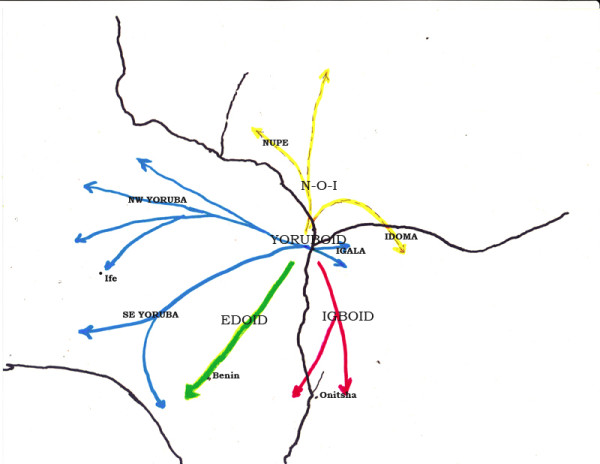Above: Mapping inferred dispersion of the “West-Benue-Congo” group of Languages
Looking back for a moment at the previous chapter, we saw that Williamson in her “Benue-Congo Overview” of 1989 (p. 272) identified the Niger-Benue confluence as the focal point for the entire Benue-Congo homeland (both West and East), while Blench in 2004 likewise stresses
“…the importance of Central Nigeria (probably the Niger-Benue Confluence) as a centre of radiation for the branches of Benue-Congo. The various branches of Benue-Congo can be seen to radiate out from it ‘like the spokes of a wheel’ in Robert Armstrong’s felicitous phrase. This in turn suggests the possibility of a riverine arrival in the region and waterways as a channel for further dispersal.”
So the upshot of all these distributions and inferred movements is a focus on the Niger-Benue confluence as an ancient heartland, both of gravity and of expulsion, for all of these (now fairly closely-related but also since widely dispersed) language groups . The previous chapter dealt primarily with a cultural object (language) that is highly abstract, that is with the prime carrier of concepts. In some of the observations that appear below, we must re-order our focus in more material directions, that is, to pursue a more materialist history, one for which “The energies of the world are understood as the invisible workings of a body, its trade routes a nervous system that powers and interconnects the global anatomy.”1.
As we have seen, the linguistic evidence indicates that the various related groups (now called West-Benue-Congo ), who today distinguish themselves as Igbo, Yoruba, Igala, Edo (Benin and others), and N-O-I (Nupe-Oko-Idoma) almost certainly spread out from some broad area skirting the Niger-Benue Confluence (where they had previously been involved in significant trading networks), and we may further suggest that their spreadings occurred to some extent in association with the previous rise of a cultural nexus centered slightly north and eastward from that location beginning around 1500 BCE The “Culture” in question has been labeled “Nok”, though some evidence suggests that they became pioneer iron-forgers somewhat later than that earliest date). 2 Linguistic experts likely have current views on the timing of the language-dispersions of these various members of the West-Benue-Congo group, but I am not aware of new perspectives in this regard; older estimates based on glottochronology are highly suspect. In any case the evidence suggests that these massive movements of linguistic ancestors were probably connected to some degree with the invention and development of metallurgy, focally iron-manufacturing.
Something connecting this geography of the Confluence with the culture history of the human populations living in the area during a crucial time produced potent dynamic sequences, generating movements not only among Benue-Congo speakers but also among those other groups on which they impinged. In other words, as we approach a time when early “Igbo” (or Igbo-id, as the linguists say) was spoken, we also become deeply involved with the meanings of what the Igbo themselves have long called “Olu“, since the geography concerns both the range and the intersection of two major rivers of the subcontinent. One key to understanding is the fact that the speakers of Proto-West-Benue-Congo (or Volta-Niger) languages share ancient vocabulary words specifically relating to elaborate patterns of trade, for example a term denoting “profit” (Blench & Dendo 2004:69). This might well point to an early (well B.C.E., “Before the Common Era”) shared location at the central hub of a (ca. ) 2000-mile east-west waterway (with its more than 200 miles of combined north-to-south additional flow) that has surely stimulated communication across the subcontinent for a very long time, and in which these ancestral speakers participated. The central Nigerian plateau and its vicinities are part of the area where these various splittings of ancient “dialect continua”, i.e. disconnections that separated formerly contiguous groups, have occurred (not simultaneously, rather over substantial stretches of time).
1. Metallurgy and Culture Change: Iron Forging, “Nok Culture”, et al
According to one of the best-respected experts on the pyrotechnologies of Sub-Saharan Africa, David Killick3, at present we simply cannot say when metallurgy reached this part of the sub-continent, nor whether it was independently invented there or was culturally diffused from North Africa, from Egypt, or even from the sub-continent of India. What does seem like a reasonable estimate for its earliest presence in the area, given the uncertainties in all the evidence, was provided by Jan Vansina4 as sometime after 840 BCE. From Vansina’s point of view (the spread of ironworking among the Bantu), an early location was somewhere on the northern Nigerian plateau, and we know that iron forges were present at Taruga (a site among hills cut through by small Niger tributaries, not far from the contemporary Nigerian capital at Abuja) along with terra-cotta figurines associated with the “Nok Culture”, probably dating somewhere near that time. This site also contained no polished-stone axes, suggesting a fully iron-using society whose farmers had dispensed with this older technology.5
Establishing iron-forging technology in this region must have, first slowly than more rapidly, transformed both land and people. The new tools facilitated clearing land for crops, and cutting timber for many purposes, for building manufactured things, having made charcoal for the iron furnaces). As Akintoye6 has observed for the ancestors of the Yoruba, Iron-making coincided with a major settlement change by promoting the growth of the settlement type Yoruba call Elu: clearings of larger farms pushed the forest away, so Elu “settlement groups” became expanding havens of more civil security and peace. Economic specializations of various kinds emerged, and trade of forest products for those of coasts, rivers and uplands increased. The appearance of the complex pottery art forms which archaeologists have labeled “the Nok Culture” suggest emergence of degrees of complexity in social organization somewhere in the region. Such developments may have generated the kinds of social ferment that are indirectly implied by the the linguistic evidence.

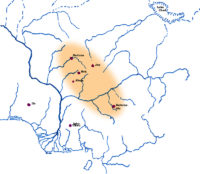 The “Nok Culture” has generated a great deal of interest for this time, in part because of the sophistication and beauty of the terra-cotta sculptures identifying it and also because of its perplexing geographic scatter with an absence of obvious center(s) of production.
The “Nok Culture” has generated a great deal of interest for this time, in part because of the sophistication and beauty of the terra-cotta sculptures identifying it and also because of its perplexing geographic scatter with an absence of obvious center(s) of production.
I think we can infer that across these spaces there were social and cultural developments — metallurgy (focally, iron, enabling radical changes in farming operations), terra-cotta sculptures suggesting elaborating social complexity), which occurred over some time and were related to the process of dispersion of these language groups. We might suggest an expansion of these major groups, following the rise of these new technologies, occurring around a broad time line of 500 B.C.E, and later into the early “A.D.’s”. Probably some increase in population densities (and pressures) occurred, increasing what became very substantial migratory movements.
2. The dispersions of Igbo: Evidence from the Dialects
The linguist Kay Williamson, who worked extensively in the Igbo language (and provided a dictionary of Onitsha Igbo), found the Igbo language group to be so diverse that at its extreme ends of relationship, one could argue that what most scholars label a single language actually breaks down into separate identifications at these extremes. (Many Igbo speakers from [for example] Onitsha have found some of the dialects in the Niger Delta area to be unintelligible for their ears.) Williamson worked using Lexicostatistics, a procedure regarded as questionable by many lingusts. I must make my own position clear here: I do not understand linguistics well enough to judge such issues. Instead, here I will simply follow the research of Victor Manfredi, who has done the definitive work so far on classifying Igbo. While I do not pretend to understand many details of this work, I present here some classification results for what they may be worth to readers.
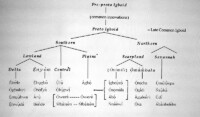
 At left, Manfredi’s classification of Igbo dialects in terms of degrees of relationship; at right, a map of the geographical distribution of these various dialects.
At left, Manfredi’s classification of Igbo dialects in terms of degrees of relationship; at right, a map of the geographical distribution of these various dialects.
The diagram at left suggests a major dichotomy (southern vs. northern) that presumably divided in motion — that is, the southern division moving south from the Benue Confluence region of origin earlier, later followed by movements by speakers of the Northern Division. The “Plains” division, characterized by Agbor in the far west of Igbo linguistic extension) apparently ceased its movement early, while the others moved on, some ending n the Central region (now the geographic “center” of Igboland,), the others continuing into the lowlands further south or far to the east. The northern group moved later, the Osimili division extending at first mainly down the Niger River, later spreading out, while the Omambala group spread south and southeast from a core area near the Anambra River.
On the Classificaiton map, Manfredi shows a “movement” out of the Osimili (Niger) branch of the Northern group westward into the “Plains” group, suggesting westward movement of language influence from that more easterly core.
“Easterly Core”: the Aesthetic Wonderland of Igbo-Ukwu
This core is also where cultural developments occurred of a complexity so astonishing that some of its early discoverers suspected earlier invasions from Europe — for example, at the time of the Italian Renaissance. Witness this archaological wonder from Igbo-Ukwlu, located in the uplands east of Onitsha and dated to the 800s-900 A.D.:

Note that this extremely complex aesthetic configuration, called a “Double-Egg Ornament” by its original excavator (Thurston Shaw), bears unmistakable resemblance to the male organ of procreation and its powers of multiplication, its two dependant “eggs” resembling human testicles, its bird limning a penis (the “cock” is a strong male symbol in traditional Igboland as well as in the U.S.A. and other Western communities). The single-minded sexual aggressiveness of adult male chickens (Gallus gallus) must be carefully observed to fully appreciate some of the implications of “the cock” as a symbol of masculine qualities, more specifically a devotion to actively expressing raw power.
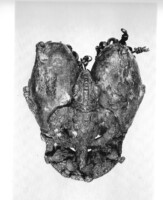 The “cock” figure is perhaps more clearly shown in this image at left. Note also what appear to be “flies” on the “eggs”.
The “cock” figure is perhaps more clearly shown in this image at left. Note also what appear to be “flies” on the “eggs”.
The “flies” shown attached to the “eggs” perhaps symbolize a condition of death (links to ancestral sources of power). Viewed from the rear, the eggs-with-bird complex displays  a double-gong, an important emblem of ritual and political importance linked with chieftaincy and kingship among Igbo-speaking peoples7 This gong may well have been musically beaten during important royal rituals.
a double-gong, an important emblem of ritual and political importance linked with chieftaincy and kingship among Igbo-speaking peoples7 This gong may well have been musically beaten during important royal rituals.
Some of the glass and carnelian beads in these elaborately varied attachments to the pendants have been traced to the “Fustat” workshops of Byzantine Cairo, indicating trade connections with that major center of international trade, and some of the metallurgic technologies — for attaching tiny additional figures (for example, the flies) to these bronze “eggs” are in some ways unique, reflecting a metallurgy in some ways unparalleled in Europe at the time (or even considerably later). The composition of the metal alloys used in the production of the bronze has an unusually high silver content and is quite distinct from alloys used in Europe, the Mediterranean or other African bronze centers.[19] The origin of the metal ore used to produce the bronze has proved to be local: old mines in Abakiliki about 60 miles from Igbo-Ukwu.8
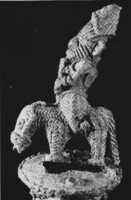
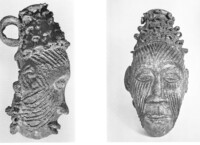 These bronze figures at left — a horse and rider and a pendant figure — link the archaeological materials directly to the Igbo-speaking residents where the materials were found: the “ichi” scars carved into the face of the “Eze Nri” — the Nri “King” — and to the “Ozo” men associated with his sovereignty. Many other features of these archaeological treasures attest to a royal complex of great sophistication, implying complex social differentiation and power.
These bronze figures at left — a horse and rider and a pendant figure — link the archaeological materials directly to the Igbo-speaking residents where the materials were found: the “ichi” scars carved into the face of the “Eze Nri” — the Nri “King” — and to the “Ozo” men associated with his sovereignty. Many other features of these archaeological treasures attest to a royal complex of great sophistication, implying complex social differentiation and power.
Another feature of the Igbo-ukwu complex is worth displaying here.
![]()

 Observe the remarkable pottery find from Igbo-Ukwu shown at left here. The pot displays iconic figures from Igbo traditional religion at several points of its circumference. At above left , at center-image, is the figure of a ram, a symbol of (among other things) the ikenga spirit powrer, central to Igbo religion. Turned about, also prominently displayed are the python and the chameleon, both closely associated with Kingship in Igboland. Then note that all around the pot are figurings of raised circles. These point directly to the fundamental presence of the Mother Earth (ani, or ala) at the base of everything. At far right, the great ethnographer of Igboland, G.I. Jones, was photographed beside a major iconic sculpture of Igboland, located near the town of Nsude in the Udi Highlands, where several of these pyramidal mud sculptures were once present (now, much eroded).
Observe the remarkable pottery find from Igbo-Ukwu shown at left here. The pot displays iconic figures from Igbo traditional religion at several points of its circumference. At above left , at center-image, is the figure of a ram, a symbol of (among other things) the ikenga spirit powrer, central to Igbo religion. Turned about, also prominently displayed are the python and the chameleon, both closely associated with Kingship in Igboland. Then note that all around the pot are figurings of raised circles. These point directly to the fundamental presence of the Mother Earth (ani, or ala) at the base of everything. At far right, the great ethnographer of Igboland, G.I. Jones, was photographed beside a major iconic sculpture of Igboland, located near the town of Nsude in the Udi Highlands, where several of these pyramidal mud sculptures were once present (now, much eroded).
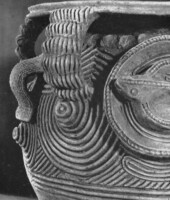 Finally, returning to this pottery masterpiece of (approximately) the 9th century AD, note in the image at left one enigmatic figre, apparently representing a rectangle of woven cloth somewhat raised above the surface at its center. I am unaware of any explanation of this figure, but I once asked Robert Farris Thompson (the noted expert on the subject of Yoruba art-history) what he thought of it. He suggested (for the Yoruba, but these ideas would be applicable to ancestral Igbo as well) that cloth worn on the human body has very potent symbolism, and more specifically, the inside surface of the cloth carries a significance of potency due to its close contact with the person who wears it. So this image of a slightly raised cloth may allude to this deep source of inner power.
Finally, returning to this pottery masterpiece of (approximately) the 9th century AD, note in the image at left one enigmatic figre, apparently representing a rectangle of woven cloth somewhat raised above the surface at its center. I am unaware of any explanation of this figure, but I once asked Robert Farris Thompson (the noted expert on the subject of Yoruba art-history) what he thought of it. He suggested (for the Yoruba, but these ideas would be applicable to ancestral Igbo as well) that cloth worn on the human body has very potent symbolism, and more specifically, the inside surface of the cloth carries a significance of potency due to its close contact with the person who wears it. So this image of a slightly raised cloth may allude to this deep source of inner power.
The “Eze Nri”
the archaeological finds in the various Igbo-Ukwu sites have been discovered on the uplands of what is now (and has long been) exclusively Igboland. Long before the discovery of these archaeological treasures, the British colonials who gained European control of this area knew at the outset of their sovereignty of the presence of a “King” (eze), namely the Eze-Nri.
I note here that, in my 1972 book, The King in Every Man, I provided an overview account outlining the significance of the Eze-Nri ((Henderson 1972:59-65, 371-3)). What follows here is an elaboration of the points made there, together with an introduction to some very significant results produced by a contemporary scholar who focused specifically on Nri (M. Onwuejeogwu).
This “royal” figure of the eastern uplands held such an extreme reputation among Ndi-igbo neighbors that once the British Masters had “pacified” the terrain early in the 20th century, their ruling officials sent an anthropologist named Northcote Thomas to study the associated community. Thomas, who later went on to survey the Igbolands west of the Niger as well, proved to be an extremely insightful exploratory ethnographer — one who engaged actively with the native languages and gained rapport with native Igbo-speakers, He did this, however, to the extent that he soon fell afoul of the British Authorities and was dismissed from the Service, partly for refusing to act as a covert spy serving the Colonial Interests of the day 9.
Norhtcdote Thomas 1913
In his report, under the heading of “Priestly Kings”,Thomas reported that The Eze-Nri “inspires great awe over much of Ibo country, so great that when probably for the first time in history, an Ezenri entered the Native Court of Awka while a sitting was going on, the whole assembly rose and prepared to flee.” 10 The Eze Nri when he emerged in public wore a long blue gown, his head covered by a tall cowhide cap surrounded by eagle feathers, and as he walked forth, behind him followed a prepubertal male child carrying (and sounding) a double bell, “gonge”. People who happened to be nearby would scatter at the sound. His personal life was surrounded by myriad taboos, for example various rituals had to be observed when he ate food: When he begins to eat, his servant says: “let no one talk: let my father Nri become a leopard.” Various customs identified him with leopards: any leopard killed should be brought to the EzeNri, and called his “son”. (The name of his central town, Agu-Ukwu, means “Great Leopard”. The leopard is on major figure of the complex of kingship .)
The Eze-Nri claimed to Thomas that he had to settle disputes everywhere he was acknowledged: Northward to Aguleri, relatively short distances to the East and South of Agu-ukwu, but to the west: all the way across the River Niger: To Asaba, to Isele, to Agbor, to “land as far as Idu (Benin city)” 11. Apprised of this claim, Thomas remarked, “But so far as I could see no disputes were referred to him at all”, though he had the important function to “vary or abolish the Nso- ani” (“forbidden acts against the Earth”),by means of making sacrifices (though, as Thomas again observed, any actual sacrifices were done not by him but by his representatives).
The characteristics of the Nri “King” thus identified,were sufficiently intriguing to colonial authorities that they sent out another anthropologist, M.D.W. Jeffreys to do a more thorough and detailed study of the culture. This he did, but unfortunately for both the reputation and the subsequent use of his work, Jeffreys was an avid supporter of an already widely discredited view proposing that the most significant early cultural developments of the world originated in Egypt and “diffused” everywhere else from there. (To “Diffuse” means in anthropological jargon, “to spread by borrowing”).
I say this was “unfortunate” because, when in 1962 I decided to consult his 1934 dissertation (hidden in the bowels of the Royal Anthropological Institute in London) I found much of the ethnographic description cogent and valuable. He did look to Egypt for proposing origins — and elaborated on this perceived connection in articles he published elsewhere –, but his detailed descriptions in his dissertation were on the whole careful and not filled with inaccuracies or inappropriately-inserted “Egypt-ifications”. For that reason I looked carefully at what he had to say.
M.D.W. Jeffreys, 1934
(Note that I present a fuller description of his work in the next page of this chapter, entitled “The Divine Umundri Kings of Igboland”. these are notes I took directly from the source; readers may delve further or skip that next page as they like.)
Early in his text he cites the findings of an pioneer ethnographer of the Igbo, Major G. Leonard,, who reported that the street of Nri is “the street of the gods”, thrrough which all who die elsewhere in Igboland pass to the land of spirits. He went on to claim that the Nri are the originators of Igbo culture; were required for ozo title-taking (the iconic personal title among many Ndi-Igbo groups) and for alu or nso (performing the necessary rituals to deal with serious violations of sacred social norms). He noted that. Nri say, contemptuously, “Igbo enwegh Eze” — Ndi-Igbo have no king. He affirmed that Ndi- Igbo say this also. Leonard went on to claim that the Nri are King-makers — ie they have the sole right to confer the title of royalty: a pineapple fibre ankelet.12
It’s important to remind readers of the ambiguities entailed in the words “igbo” (or, in the Europeanized version, “Ibo”). As I discuss elsewhere, the word “igbo” may refer to the language, or it may refer to a group of people living in uplands terrain (who likely, but not necessarily always, speak that language). In the present example, the historical people of Nri were (and are) speakers of the Igbo language, but they (historically) sharply distinguish themselves from “Igbo-people” (Ndi-igbo). Presuably, the y were distinguishing themselves from these “others” in terms of dialect differences.
So Jeffreys was well aware that the Nri reputation was one of remarkably widespread influence. When he asked about the historical origins of the Nri, his consultants said nothing regarding a migration out of the Niger-Benue Basin (which the current historical-linguistic evidence dictates, as we have seen). Rather, he was told various versions of a story that goes like this. All “first things” happened at Aguleri (at the northwestern edge of the Nri-Awka uplands where these meet the vast Anambra floodplain south of the Niger-Benue Confluence.) . There, the Great God (Chukwu) sent his son Eri and his wife Amuku down from the sky, so that Eri found himself standing in mud, a morass –there was water everywhere around them . He complained to Chukwu, and so Chukwu sent him an Awka man with fire, bellows and charcoal, who performed the deed of drying out the land. (Thus the location of Aguleri — Eri place — has primordial designation, and thus the town of Awka also has it. by virtue of this condition, Awka men also were traditionally free to travel unmolested over the entire range of Nri infliuence., peddling their iron morks.)
Then Eri asked for food, and Chukwu made a bargain: he sent a Dioka man (who specialized in cutting the Ichi facial scars for men taking Ozo title), and directed Eri to have his son’s and daughter’s faces cut with Ichi marks, then sacrifice them, bury their heads separately in the ground, which he did. Out of the son’s head grew yam and out of the daughter’s, Cocoyam, thus providing food for the hungry people.
The reference to “Dioka” identifies a second community as “primordial”: the town of Umu-dioka, located east of today’s Ogbunike, not far from Nri. .This community holds the right to perform tthe ritual of cutting the ichi scars on the foreheads of those receiving the Ozo title, and like the men of Awka, they were free to roam everywhere sanctioned by Nri to perform these duties, using their ritual “knife of sacrifice” (mma nka). (They also acted as doctors, providing medicines (igwe ogwu) of various kinds.
This is not only a remarkably moralistic Origin Story — I will say more about it shortly — but also a noteworthy erasure of cultural history. In it, one of the most elaborate pre-modern cultural traditons (given the sophistication of its metallurgical crafts) “came out of the sky” (in order to construct the uplands on which the primary members of Nri culture could stand). Nothing relevant existed before this, anywhere.
Let us pause here, first recalling our previous grasp of the cultures brewing in the Niger-Benue basins after the beginnings of dispersion.
Consider a hypothetical center, containing artists and masters of the highest quality and sophistication, but then packing up and moving the entire operation off to the south, eventually arriving at a remote “wilderness” without the slightest look back. In fact, the oral-historical evidence suggests that even taking a look back must have been forbidden by authoritative leadership. Otherwise there would be some oral tradition traces of “migration”, but according to the recorded oral myth (Thomas; Jeffreys), there was nothing at all prior to arrival at Aguleri prime-spot, where the Great God created everything (with a little help from his friends).
We must assume then that the bronze-and-iron masters who later created the Igbo-Ukwu masterpieces traveled down the Anambra river drainage from a trade center somewhere (east of ?) the Niger-Benue confluence (where they had mastered both iron-working and the lost-wax bronze techniques –using latex for this method — some time before). Judging by their mythology, they must have been somewhat river-bound, since their prime origin must have begun very closely involved in water. (Another interesting aspect of this is the absence of canoe-building as part of the technology of the surviving people, perhaps another sign of an abrupt and deeply-committed cultural change.)\
Jeffreys wrote a great deal about Nri and its kingdom; the bases and nature of its wider influence and social control over neighboring (and more distant) peoples. One part of this influence is his claim that the Nri king once “crowned the Kingds of Benin” (and it is clear that the Bini historians knew of Nri also) And the elaborate (and ultimately crippling) array of taboos surrounding the Eze-Nri’s person, forcing him into an effective seclusion, kept strictly apart from his “subjects” due to his enormous charismatic powers, could explain some aspects of the gradual dissolution of this Kingdom.
More will be said of this further below. Here, I will just present a gross summary of the Eze Nri’s instituting circuit of rituals which I provided in my 1972 book The King in Every Man.
An Erasure of History
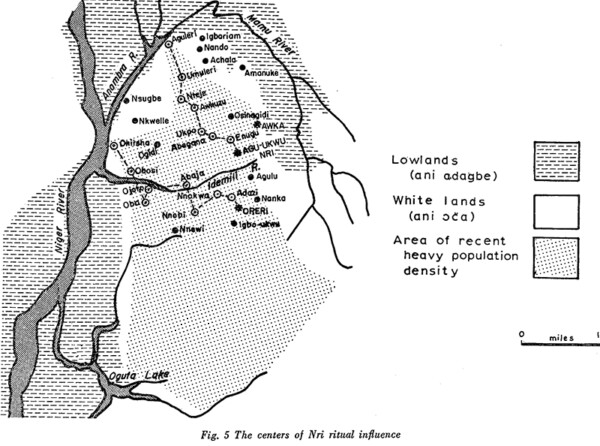
Here I recapped some of Jeffreys’ account of distinctive ritual circuits followed by Nri kings located in the two Nri centers he had identified — the main center at Agu-ukwu and the later breakaway center at Oreri. These two circuits marked a ritual “return” — for the original kingdom, to the place of origin at Aguleri, and a second route forged later after the breakup (which had to substitute the River Niger for the Anambra “origin” place).
Human Sacrifice of Own Offspring
Now, here note another major aspect of this story: the culture hero is directed by the Great God to conduct human sacrifice, not just of a fellow human being, but of his own first son and daughter. This directs those of us informed by the Judeo-Christian tradition to recall the story in the Book of Genesis 22 where God directs Abraham to sacrifice his son, a tale the moral lesson(s) of which have occupied scholars for many centuries. Here we have a comparable, and even more appalling case to consider.
I do not intend to become embvroiled in such questions here, but I think it worth noting that both traditions propose a kind of altruistic heroism very hard to understand, but which direct attention to the importance of giving up personally-limited human interests for the benefit of some longer-term and wider-ranging humam good. The Nri case is particularly intriguing because one form of resolution of the dilemmas would be to substitute the incising of first-born children with the marks of Ichi scarification for the killing, such elaborate scarificaiton amounting of course to a dangerous injury which might well have mortal consequences. This in any case was what the taking of Ichi –and therefore Ozo title –would imply. 13
Such ritual patterns outlined the sphere of influence Nri held among the Northern Igbo east of the Niger. But while Jeffreys provided some stimulating descriptions, a later ethnography revealed a much wider and ecologically-founded understanding of Nri history.
The work of M. Onwuejeogwu 1981
Onwuejeogwu, an Igbo–speaking ethnographer (finally!), was selected by the Institute of African Studies at the University of Ibadan to make an in-depth study of this remarkable community. His on-site research there, from 1966-72 (interrupted at times by the Biafra Civil War), resolved many of the questions regarding the significance of this ancient, long-suffering “Igbo Kingdom”.
Onwuejeogwu proceeds from an ecological perspective: the soils of the entire heartland of the Nri phenomenon are largely infertile, and are probably “responsible for the series of famines well remembered in the oral traditions of the people.” The combination of dense population and rapidly-eroding, delclining-fertility soils must date back many centuries into the past. This grisly prospect was confronted — when faced by the builders of this community — by constructing a society and culture emphasizing expanding efforts to (1) stimulate intensive self-control aimed at expanding production to serve others, and to export valuable social and cultureal techniques, enforcing these processes not by military threats and actions but by ensuring conditions of peace. Lonely leaders identifying themselves in part by carrying iron “spears of peace” traveled beyond their domains, protected only by the symbols they carried.
As he puts it, Nri hegemony and state system were based on the ritualization of the political system and domestic economy: markets were linked with supernatural beings (named as the four-day week), produce ritualized in yam (and cocoyam, oil palm, breadfruit) cults. Leadership was ritualized in the Ozo title, directly controlled by the king of Nri. Farming gear, spears, swords — various technologies were ritualized. Earth was ritualized as supernatural force: it was held to be an abomination to spill human blood in violence on the surface of the earth.
Concepts of peace, harmony, and truth were ritually enacted by the Ozo men’s rituals: those who had taken Ichi (facial scarification) title carried the spear of peace which, with their Ichi scars, established that they were “nwa- Nri”, sons of Nri, enabled to travel unmolested from one Igbo settlement to another, as agents of Eze Nri, to remove the negative effects of acts of abomination, change codes of abomination, crown chiefs, make peace, to create markets and shrines. In this way Nri people spread into different parts of Igbo-speakking lands, formed settlements,generally exercised some degree of social control. And along with these ritual leaders came iron-workers (the famous Awka craftsmen), providers of medicines, and diverse other specialists bringing benefits, all able to travel through an otherwise dangerous countryside due to their Nri affiliations.
Thus a hegemony based on religious ascendancy was established. That its influence reached at one time all the way to the Kingdom of Benin was acknowledged even by that empire’s early European-educated historians14. All of this occurred before the Benin Kingdom became established.
The term “hegemony” is significant here. As Manfredi has put it, Nri was a large-scale formation which lacked the technological monopoly on violence which many social scientists regard as defining a “state”. — i.e. “means of destruction”. Using the political theorist Gramscis definition of the state as “hegemony plus coercion” — in these terms, Nri was half a state, but not the expected half. For all its influence and achievements across a large area, Nri was not at all militarist. Instead, Nri relied on manipulation of various cults by a migrant, oral intelligentsia, people who were recruited by ichi initiation and possessors of a “secret language” (olu). This gave them “hegemony” — an accepted social and cultural superiority — over the rest of the populace 15 .
Onwuejeogwu goes on to outline an overview of various stages of the expansion of Nri influence into the lands west of the Niger, culminating in a late period of “decline”. While he assigns specific dates to these stages, I do not feel competent to assess their accuracy here, nor do I think that is needed for this account. Here I simply attach his diagram to give readers some sense of his views.
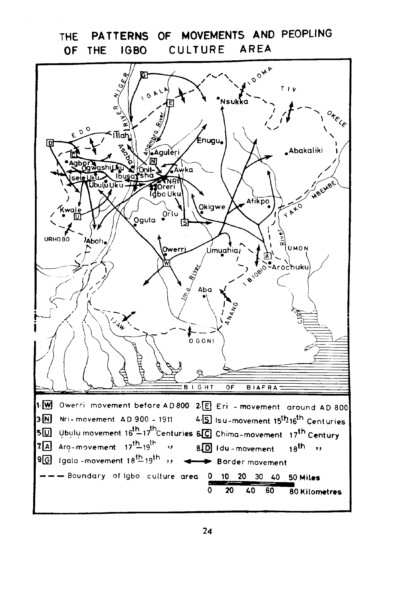
What we do know from historical records is that, beginning around 1500 C..E., European contact along the Atlantic coast of this region introduced drastic and long-term changes in the societies and cultures located there. The focus of these changes was military, specifically the introduction of European firearms including cannons into the hands of societal leaders there, and the encouragement of these leaders to use their weapons superiority to pursue the acquisition of slaves for sale to the Europeans. Training in European-style military tactics was part of the Portuguese “gift” to Benin
The Kingdom of Benin became in this way an active invader of other lands, marking their conquests not by acquisition of territories but by taking slaves and imposing relationships of indebtedness on the part of those defeated in combat.
In the Western part of Igboland, Benin intruded in many ways and over a considerable period of time. These intrusions produced as defensive reactions some new kinds of militant kingdoms among the Igbo-speaking towns there, including the Kingdom of Aboh (which sought and succeeded in migrating to and capturing the Niger Delta lands controlling access to the Niger River slave routes), and also the Kingdom of Onitsha (which migrated across the River to encamp on an eastern route, as we have seen). All the Western Igbo cities were affected by this process to some degree, their leadership patterns incorporating Benin-like “military chieftaincies” that lessened (but did not destroy) the strength of Nri–influence in settlements there. 16
In the east, a comparable but somewhat different transformation produced the Aro trading network, which at first penetrated eastern Igboland more stealthily, trading for slaves using for example the elaborate ritual means epitomized by use of the “Aro-Chukwu” oracle, but these methods were gradually supplemented by employing mercenary “armies” to attack villages. The Aro eventually penetrated all the way to the vicinity of Nri (and beyond), penetrating and disrupting (but not conquering) those places.
We learn from Jeffreys’ dissertation that the Nri central place — Agu-Ukwu — was an “Emporium” of a distinctive kind. Not only was it said to be the ultimate “pathway” for deceased persons to “pass through”; it was, at the visibly human level, the place where those living persons who had committed offenses too grave for their local towns to manage were sent to reside — escorted by itinerant Nri agents. And there, these “abominables (ndi-so-ani) were disposed of by being sold into slavery. 17. In this way, Nri too may have became to some extent a part of the Aro-Chukwu slave-trading system .Onwejeogwu, on the other hand, argues that the Nri Kingdom was unique in Igboland in the extent to which its followers did not regard slaves as a distinctively “dispensable” resource.
- Thubron 2016:41. [↩]
- See Frank & Breunig 2013 on matters of Nok dating. [↩]
- 2016: [↩]
- 2006:332 [↩]
- Alpern 2005: 124-6. [↩]
- 2010: 19-20 [↩]
- Shaw 1970:Pl.275 & 277. [↩]
- Chikwendu et al, 1989 [↩]
- Basu, Paul, 2015 [↩]
- Thomas 1913:48 [↩]
- Ibid.:52 [↩]
- Leonard:18-20. [↩]
- Note that M. Onwuejeogwu, whose work is outlined directly below, reported that his consultants, when informed of this (Jeffreys’ reported) “tradition” of deity-imposed offfspring sacrifice, loudly denied the possibility that such a practice might have occurred in Nri at any time. This suggests a likelihood that the practice was a “just-so” story fabricated by storytellers embellishing their history. [↩]
- e.g. Egharevba 1960 [↩]
- Manfredi [↩]
- See for example Okpewho 1988. [↩]
- (Jeffreys op cit [↩]
